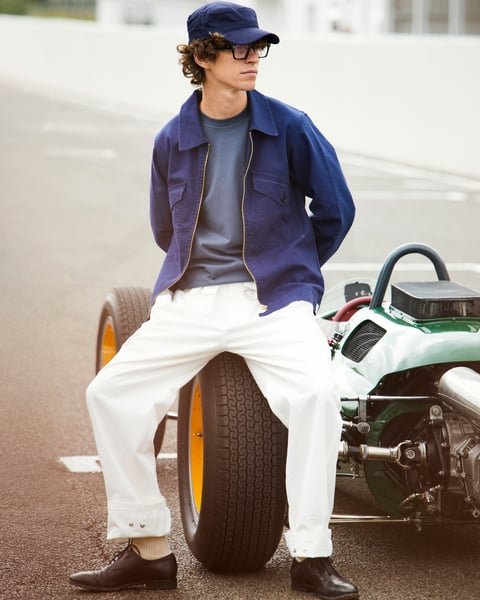The Formula 1 design legend’s quest for downforce, downforce and even more downforce is plain to see in this updated second prototype. But while F1-style solutions dictate the aerodynamic function, Aston Martin’s design team under Marek Reichman have married it to an aesthetic form entirely true to the original but – in our view at least – even more spectacular.
That, of course, is entirely befitting of what is billed as the closest thing yet to an F1 car for the road, offering LMP1-matching pace on a circuit while still able to take two people on a touring holiday in air-conditioned comfort.
It was always clear that the only Valkyrie so far seen – most recently on the Michelin stand at the Festival of Speed presented by Mastercard – had a way to go before the 150 road cars (plus 25 track-only versions) were built. The original car’s headlights, for example, were merely drawn on. Other details were far from resolved.
Now 95 per cent of the car, according to director of exterior design, Miles Nurnberger, is finished. Handily that’s exactly two months before what promises to be its nemesis, the Mercedes-AMG hypercar powered by a real F1 engine, is due to be unveiled at the Frankfurt Motor Show.
Alas at this stage while we can savour the best pictures yet of the Aston’s interior and exterior design, we still can only speculate on figures such as 1,000bhp, 1,000kg weight and a price between £2-3 million, with first deliveries in 2019.
What we do know is that, incredibly given the car’s compact size and almost fragile appearance, somewhere under that carbon fibre skin is a drivetrain comprising a bespoke 6.5-litre naturally-aspirated V12 Cosworth engine, with a Rimac hybrid battery electric system and a tailor-made seven-speed paddle shift transmission from Ricardo. Guess it takes the packaging genius of Adrian Newey – F1’s most successful designer with a record 10 world championship-winning F1 cars – to pull that off.
So what exactly is new for Valkyrie? Here’s our eight-point tour to the mightiest supercar yet devised…
1. Aero
Most obvious visual change is the openings in the body surface between the cockpit and front wheelarches. Miles Nurnberger says: “The last thing we’d want to do to one of our surfaces is cut a hole in it, but these vents work the front wings so much harder that there is a significant gain in front downforce.”
A bonus is that you can literally see through the car, with a great view of the wing-section front wishbones.
The new pictures clearly show not only this but also the full-length venturi tunnels that run either side of the cockpit floor, drawing huge quantities of air to feed the rear diffuser – key to achieving downforce without the need for spoilers on the upper body.
2. Cabin
The teardrop-shaped cockpit doesn’t only accommodate two people, it is said to comfortably take two Marek Reichmans, and he’s 6ft 4in.
The key is seats which are mounted directly to the tub and a reclined feet-up driving position similar to an F1 or LMP1 car’s driving position (also just as the Elemental RP1 features, and what the McLaren P1 was going to have at one time).
3. Access
We have always known the Valkyrie was going to have gullwing doors but this is the first time we have seen how they operate.
Bit of a climb to get in do you think? Apparently not, as Aston’s interiors creative director Matt Hill says: “It has been fantastic seeing customers try the interior buck for size. They love the ritual of getting in and how it feels to be sat behind the wheel. They’re also genuinely surprised at how the car just seems to swallow them. You really do have to sit in it to believe there is genuine space for two large adults.”
4. Controls
There aren’t many of them, and all of the switchgear is mounted on the detachable oblong steering wheel, with the car’s vital signs displayed on a single OLED screen. It is an incredibly minimalist cockpit.
5. Visibility
Aston says the glasshouse design ensures forward and peripheral side-to-side vision is virtually uninterrupted. But do not expect to see out of the rear window – there isn’t one.
Conventional side mirrors – not very aerodynamic – have been ditched in favour of rear-facing cameras in each of the Valkyrie’s flanks that display the rear view on screens at the base of each A-pillar.
6. Headlights
Yep, this road-registerable car has headlights now (we’re still not sure where the number plates go, though…). The lights are said to mimic F1 in their bare functionality while looking cool and being 40 per cent lighter in weight than a series production Aston’s headlamps.
7. Rear brake light
Even F1 cars for the road need one of these. The Valkyrie’s centre light is a 5.5mm wide LED strip (world’s smallest, apparently) mounted on the tip of the shark’s fin that runs down the spine of the Aston Martin Valkyrie’s airbox and rear bodywork.
8. And finally… the Badge
This must be the most extreme example of weight-saving ever. The regular Aston Martin ‘wings’ badge was considered too heavy, and a simple sticker not up to snuff. So the Valkyrie gets a chemical-etched aluminium badge that’s 30 per cent thinner than a human hair – and a remarkable 99 per cent lighter than the regular enamel badge.
We suspect Adrian Newey had something to do with this…
Aston Martin
Valkyrie





















